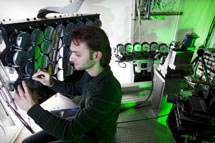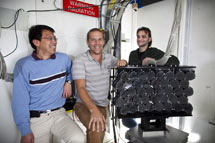
Handy Links
SLAC News Center
SLAC Today
- Subscribe
- Archives: Feb 2006-May 20, 2011
- Archives: May 23, 2011 and later
- Submit Feedback or Story Ideas
- About SLAC Today
SLAC News
Lab News
- Interactions
- Lightsources.org
- ILC NewsLine
- Int'l Science Grid This Week
- Fermilab Today
- Berkeley Lab News
- @brookhaven TODAY
- DOE Pulse
- CERN Courier
- DESY inForm
- US / LHC
SLAC Links
- Emergency
- Safety
- Policy Repository
- Site Entry Form

- Site Maps
- M & O Review
- Computing Status & Calendar
- SLAC Colloquium
- SLACspeak
- SLACspace
- SLAC Logo
- Café Menu
- Flea Market
- Web E-mail
- Marguerite Shuttle
- Discount Commuter Passes
-
Award Reporting Form
- SPIRES
- SciDoc
- Activity Groups
- Library
Stanford
Around the Bay
SSRL Gains New Spectrometry Capabilities
A new spectroscopy instrument has been installed on Beamline 6-2 at the Stanford Synchrotron Radiation Lightsource, where staff scientists are now working to test its various components before offering beam time to users this spring. The setup will expand SSRL capabilities in X-ray Raman and X-ray emission spectroscopy—two techniques used to analyze the organization of electrons in solids, liquids and gases—and keep SSRL positioned as a leading synchrotron user facility.
"This will open up the science to a whole new set of users," said SSRL staff scientist Dennis Nordlund, who is part of the team building the instrument. According to Nordlund, the higher intensity and better resolution offered by the X-ray Raman instrument make it a very competitive alternative to soft X-ray spectroscopy. What's more, he says, it overcomes many technical limitations that come with soft X-ray studies, such as the need to operate under a vacuum.
"The main things holding X-ray Raman spectroscopy back were intensity and resolution," Nordlund said. The main feature of the new X-ray Raman spectrometer is a 40-crystal array made up of four-inch bent and diced silicon wafers. A beam is scattered off a sample and then hits the crystals, which redirect and focus the beam onto the same spot on a detector. The new spectrometer increases the intensity of this signal by about a factor of three over the previous instrument.
On the resolution side, the new spectrometer will be able to resolve features down to 0.25 eV, which Nordlund explains is about as small as necessary to study most light elements. Incoming photons lose a small amount of energy when they scatter off a sample. Measuring the spectrum of this energy loss provides information about the electronic and, indirectly, geometric structure of a specific element. Being able to identify smaller and smaller spectral details means having better information about the material.
The group also built a second spectrometer, a seven-crystal array that will be used for X-ray emission spectroscopy and a multitude of related techniques. Researchers can use this instrument to map out the structure of an element's outermost electrons, where chemical processes occur.
Beamline 6-2 also gained several mechanical upgrades that allow scientists to switch samples and realign the machine more quickly. Data gathering will be faster, too. As the SPEAR3 electron storage ring approaches its full design current of 500 mA, further boosting the speed and resolution of data collection, "we can push this instrument from hours [of data collection] to 20 or 30 minutes per spectrum," Nordlund said. "Not only will this let us do more science in the same amount of time, it will also change the scope from studying model systems to studying systems in their real environment, for example a working catalyst."
These new capabilities open doors to better science in many fields. Environmental scientists will be able to test dilute samples for elements down to parts per million. Chemists and biochemists can monitor behaviors of metals in inorganic complexes or proteins. On the energy front, battery and hydrogen storage researchers will be able to examine the transformation of materials as the surrounding temperature and pressure change. It will also improve research in catalysis, photovoltaics and matter under extreme conditions.
Two years ago, then senior staff scientist Uwe Bergmann (now Deputy Director of the Linac Coherent Light Source) secured $1 million in funding from the American Recovery and Reinvestment Act for this project. "Uwe Bergmann built up a strong scientific base in X-ray Raman spectroscopy and hard X-ray spectroscopy with the previous SSRL setup," Nordlund said. "With our new hires, hard X-ray spectroscopy scientist Tsu-Chien Weng and research associate Dimosthenis Sokaras, we are rapidly ramping up the scientific spectroscopy program at beamline 6-2 and exploring new scientific directions." The ARRA team is working hard to finalize the instrument installation and commission by March. User proposals are scheduled for beam time beginning in April.
The combination of scientific and mechanical upgrades will draw many top-level scientists to SSRL, where they can conduct X-ray emission spectroscopy and soft X-ray Raman spectroscopy more quickly, easily and at higher resolutions than before.
"Currently there is nothing out there like this," Nordlund said. "The ARRA team has done a tremendous job to ensure that we will have a state-of-the-art instrument for years to come."
—Lauren Rugani
SLAC Today, February 1, 2011

